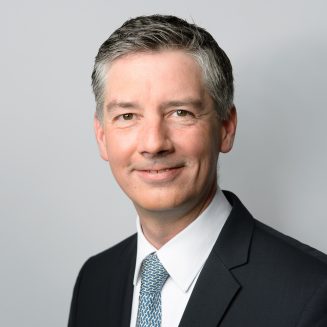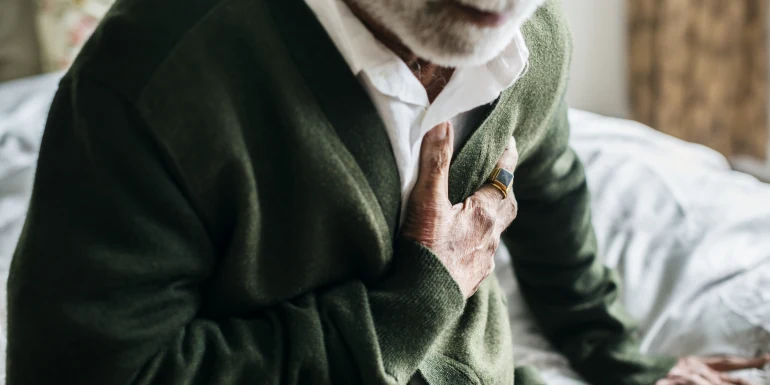
Cardiac arrhythmias
The heart beats in a certain rhythm which occasionally becomes disordered. Why cardiac arrhythmias occur and how they can be treated.
Every heartbeat pumps blood through our body. Electrical impulses arising from the heart itself set the pace. Pacemakers are muscle cells specialised for generation of electrical signals. The most important of these lie in the sinus node in the right atrium of the heart. The impulse of the electrical signal first stimulates the atria, then the ventricles, thereby causing the heart to contract and beat. This occurs 60-80 times a minute in adults.
What is a cardiac arrhythmia?
Additional heart beats (extrasystoles) may occur in all human beings and are usually harmless. If, however, the heart beats too fast, too slowly or too irregularly for an extended period of time without an apparent cause, a cardiac arrhythmia is said to be present. Arrhythmias are mostly harmless. They may however give rise to symptoms and may require therapy. Some cardiac arrhythmias may cause sudden cardiac death. Affected patients require immediate treatment.
Preventing heart rhythm problems with the Helsana Coach app
With a healthy lifestyle, you can reduce the risk of heart rhythm problems. The Helsana Coach app helps you by providing tips on and suggesting activities relating to exercise, nutrition and mindfulness. Download the Helsana Coach app now and get going.
Why cardiac arrhythmias occur
An arrhythmia is triggered by a disturbance in the sinus node or in the conduction system. The latter carries the impulse from the sinus node to the ventricles. Bradycardia is said to be present when the heart rate is less than 60 beats per minute, while tachycardia implies a heart rate of over 100 beats per minute. These disorders may be due to coronary heart disease. A heart attack, high blood pressure or stress may all cause a rapid, slow or irregular cardiac rhythm.
Cardiac arrhythmias may give rise to the following symptoms
Cardiac arrhythmias may give rise to a variety of symptoms. Too slow a heart beat may give rise to skipped heartbeats, dizziness or drowsiness. Too rapid a heartbeat often presents as palpitations or nervousness. Other symptoms may include tightness or a pressure sensation in the chest. Sweating, fatigue or shortness of breath may also occur.
Different symptoms may also be perceived differently. Some patients never realise that they have a cardiac arrhythmia, while others find their symptoms extremely alarming.
The most dangerous cardiac arrhythmias
The heart cannot pump enough blood if the ventricles beat too rapidly. Patients may feel very ill and may experience palpitations, dizziness, shortness of breath and tightness in the chest. This is an emergency since ventricular fibrillation may result which in turn may cause cardiovascular arrest.
Atrial disorders are usually not dangerous.
Atrial fibrillation is the commonest cardiac arrhythmia, affecting almost one percent of the population. Men are more likely to have atrial fibrillation than women. Atrial fibrillation is often due to old age.
It may be triggered by abnormal electrical activity in the left atrium, due to which the atria beat rapidly in an uncoordinated fashion. These impulses are transmitted to the ventricles. Stroke is a dreaded complication of atrial fibrillation. Possible symptoms of a disordered heart rate include palpitations, shortness of breath or generalised weakness. Atrial fibrillation may however frequently not give rise to any symptoms at all and the disorder is incidentally detected during a routine examination. Patients are treated either with medication or a small operation.
How are cardiac arrhythmias diagnosed?
A physician should be consulted in case symptoms referable to the heart such as palpitations are present. The doctor will first discuss your medical history which provides valuable information about the diagnosis. Investigations are then performed with the help of various devices.
The electrocardiogram
The electrocardiogram (ECG) is most commonly used in the diagnosis of cardiac arrhythmias. This may either be an ECG at rest, long-term ECG or stress ECG.
The ECG records the activity of the heart via electrodes attached to the skin, which conduct electrical impulses from the heart. Physicians identify atrial and ventricular activity based on the curves on the monitor, and thereby diagnose the presence or absence of a cardiac arrhythmia. Irregular heartbeats give rise to irregular curves, and the nature of the curve allows the physician to obtain important information about the type of disorder.
Other diagnostic methods may be employed after the ECG if necessary. These include x-ray images, blood samples or echocardiography, an ultrasound examination of the heart.
What helps in cardiac arrhythmias
Many patients suffer from harmless cardiac arrhythmias and do not require any treatment. Various modes of therapy, including drugs, are however available for common and disturbing symptoms. Procedures not involving the use of drugs may also be employed, the commonest of which is catheter ablation. Areas in the heart causing the arrhythmia are ablated during this procedure. An implantable defibrillator may be used in patients with dangerous arrhythmias. In an emergency, this may produce an electrical shock if necessary and may thereby help restore cardiac rhythm.
How can this condition be prevented?
The risk of developing a cardiac arrhythmia increases with age, and is therefore obviously unavoidable. One may reduce the risk of developing this ailment if one follows a healthy lifestyle.A healthy diet and optimal weight are therefore of prime importance. Regular exercise is also important for the heart: this counteracts the risks posed by obesity and hypertension. Cessation of smoking and drinking alcohol in moderation are also recommended. Prolonged stress can also strain the heart. Relaxation exercises may help with cardiac arrhythmias due to anxiety and provide much-needed rest for the heart.

Dr Robert C. Keller is the Managing Director of the Berne-based Swiss Heart Foundation. He has long-standing experience in the field of cardiovascular diseases and heads up the areas of research and prevention at the foundation. Dr Keller provided the editorial team with advice.



Newsletter
Find out more about current health issues every month and get all the information you need about our attractive offers from all Helsana Group companies * delivered by e-mail to read whenever it suits you. Our newsletter is free of charge and you can sign up here:
We did not receive your information. Please try again later.
* The Helsana Group comprises Helsana Insurance Company Ltd, Helsana Supplementary Insurances Ltd and Helsana Accidents Ltd.
